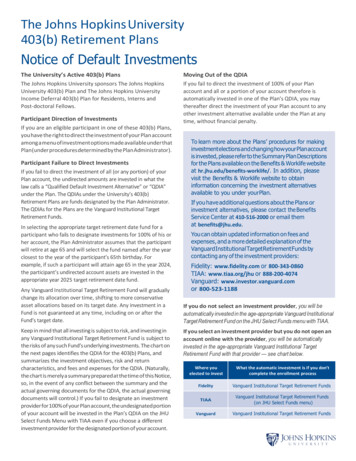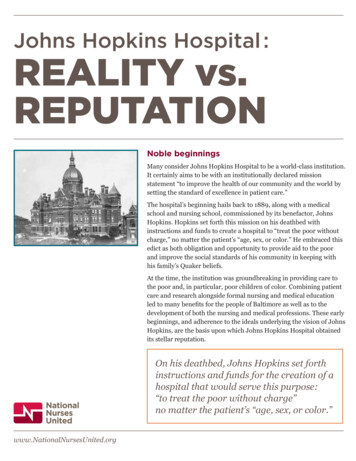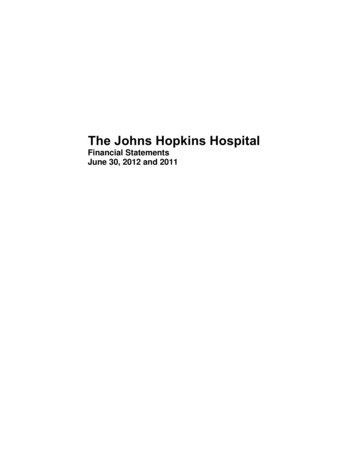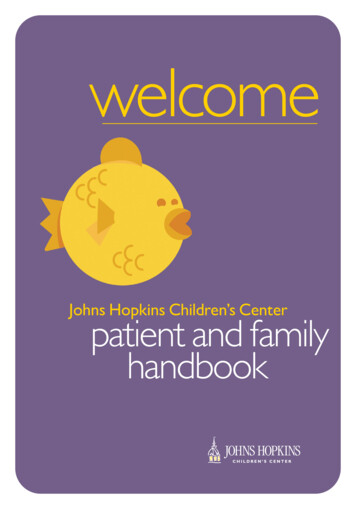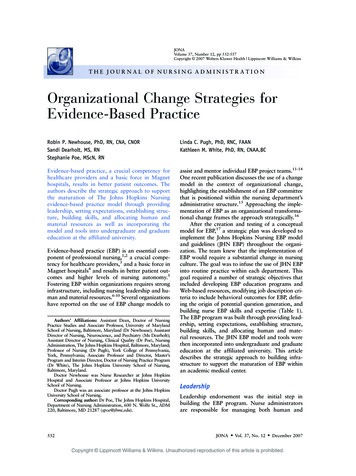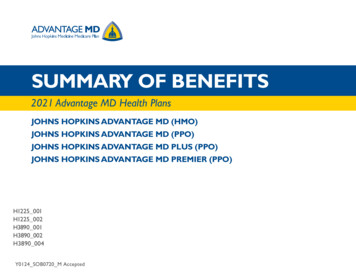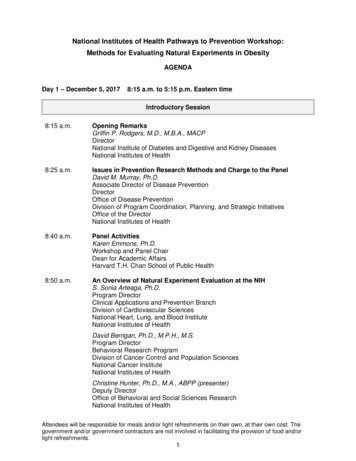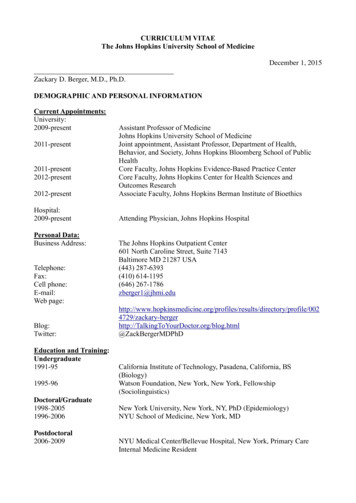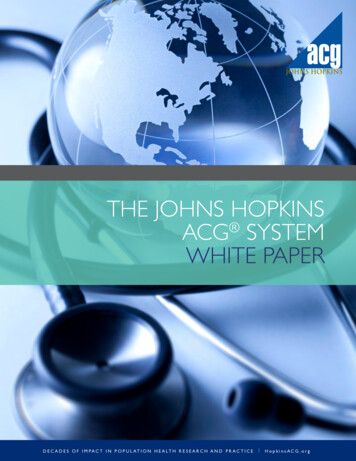
Transcription
THE JOHNS HOPKINS ACG SYSTEMWHITE PAPERD E C A D E S O F I M P A C T I N P O P U L AT I O N H E A L T H R E S E A R C H A N D P R A C T I C E HopkinsACG.org
TA B L E O F C O N T E N T SINTRODUCTION3PERFECT STORM: CHALLENGES FACING THE INDUSTRY3Soaring Costs3Aging Population and Growing Morbidity Burden3Case-by-Case: Challenges at the Local Level4THE ROLE OF ACG SYSTEM4Population Health5Patient Care Management5Finance/Budgeting5Performance Analysis5UNIQUE STRENGTHS OF THE ACG SYSTEM6Patient-Centric Methodology6Total Population Assessment6Track Morbidity, Not Activity7Proven Reliability7Full Spectrum of Applications7Flexible and Customizable7Continuous Development at Johns Hopkins8MORE INFORMATION2D E C A D E S O F I M P A C T I N P O P U L AT I O N H E A L T H R E S E A R C H A N D P R A C T I C E8 HopkinsACG.org
PERFECT STORM: CHALLENGES FACING THE INDUSTRYFI N TROD U C T I O NTHE JOHNS HOPKINSACG SYSTEM is a leadingrisk measurement methodology that was developed andcontinues to be tested andimproved at the BloombergSchool of Public Health.Johns Hopkins remainsextremely committed to theongoing development of theACG System as it supportsits overall mission topromote equitable,effective, and efficienthealth care around the globe.For over 30 years, publichealth officials, hospitaladministrators and healthcare providers throughoutthe world have used theACG System for a variety ofapplications ranging from caredelivery, clinical case management, evaluative research,finance, and administration.The system consists of acomprehensive suite of toolsto improve quality of care,better predict resource utilization, and to reduce costsand improve efficiency in thehealth care sector. The ACGSystem converts patient datafrom a variety of sources –diagnosis codes, pharmacycodes, and laboratory codes into actionable information.The challenges facing the U.S. health care industry are formidable. The situation isalready convoluted and several prominent health organizations anticipate the situationis likely to worsen in the coming years. In fact, several factors are expected to cometogether to create a “perfect storm” within the industry.Soaring CostsThe Centers for Medicare and Medicaid Services estimates that total health carespending in the U.S. will reach 4.8 trillion by 2021, nearly doubling the 2.6 trillionspent in 2010. The main drivers behind this trend are rising hospital and providercosts, as well as advances in medical technology and pharmaceutical drugs.Aging Population and Growing Morbidity BurdenPerhaps the most significant factor on the horizon is the aging U.S. population. Thefirst baby boomers reached age 65 in 2011 and seniors are expected to comprisenearly one-fifth of the population by 2050. The CDC projects that longer life spansand aging baby boomers will combine to double the population of Americans aged65 years or older during the next 25 years to about 72 million. By 2030, older adultswill account for roughly 20% of the U.S. population.As our population ages and the prevalence of chronic conditions spirals, so does theneed to accurately track the impacts of multimorbidity burdens on a community orpatient population. The growing burden of chronic diseases among the populationadds significantly to escalating health care costs. Researchers at the Milken Instituteproject a 42% jump in chronic disease cases by 2023. Many chronic conditions canbe managed through lifestyle choices, medications and other preventive measures.However, problems arise when patients with one or multiple chronic conditions fail toadhere to medical treatment and medications.This white paper willdescribe the key applicationsand unique benefits of theACG System.D E C A D E S O F I M P A C T I N P O P U L AT I O N H E A L T H R E S E A R C H A N D P R A C T I C E HopkinsACG.org3
Case-By-Case: Challenges at the Local LevelRegardless of the widespread industry challenges, medicine is practiced and dispensedat the local level, which often renders big-picture solutions impractical. For the mostpart, health care officials and administrators must determine how to improve carewithin their communities on a case-by-case basis. A solution that can combinea bird’s-eye view of the population with a patient-level view of behaviors andconditions is critical for practitioners, health care officials, and administrators to:n Targetpatients who are at high-risk for hospitalization, high pharmacy use, orother costly services for early preventive caren Trackchronic care patients prone to medication errors, to better gauge clinicalperformance, cost of care and outcomesnP redict the prevalence of disease within subgroupsn Assessthe demand for services (by population subgroup) in order toallocate appropriate resources. Measure and contrast performance ofclinics/practitioners based on the case mix of their patient populationTHE ROLE OF THE ACG SYSTEMThe ACG System is built to handle the complexities of health care informationflows, coding standards, and various systems. It can source data from individualpatients’ primary and secondary care records and make it available for use in awide range of applications that are relevant to practitioners, administrators, healthinsurance plans and public-sector agencies. The ACG System’s hallmark isits unique “person-focused” approach which was developed to capture themultidimensional nature of an individual’s health at a given point in time.The ACG System is the only population-based methodology that is fully adaptable toa local context, impacting close to 200 million lives in nearly 30 countries. It includesfunctionality for easy translation and can incorporate local cost structures, codingsystems and local markers including socio-economic, functional status, livingarrangement, or other dimensions relevant to the local health care setting.The ACG System has clinical and administrative applications, which fall into fourbroad categories:4D E C A D E S O F I M P A C T I N P O P U L AT I O N H E A L T H R E S E A R C H A N D P R A C T I C E HopkinsACG.org
Population ProfilingnM easure the morbidity distribution of a population or subgroupn Trackdisease prevalence in the population or among subgroupsnF orecast health care utilization for the population by cost and type of servicenP rovide data points that help channel resources to meet demandnS upport service optimization and patient engagementPatient Case ManagementnO ffer input for care management and disease management for the individualpatientnI dentify patients at high risk for hospitalization, readmission and highpharmacy usenI dentify care coordination issuesnI dentify patients for preventive care, wellness and education servicesnI dentify medication adherence issuesnI dentify gaps in care to target for improved quality of care and patient outcomesFinance/BudgetingnI dentify waste, inefficiencies and redundancies contributing to highoperational costsnE valuate bottom-line costsnE stablish equitable payment rates based on population case mixnP redict prospective cost risk at the population and individual patient levelPerformance AnalysisnS et fair performance benchmarks among providersnC ompare and contrast groups of providers, employers or health insurance plansto evaluate morbidity risk and cost risknC alculate care density ratio to measure the degree of physician patient sharingas a proxy for the number of referral relationships among providersD E C A D E S O F I M P A C T I N P O P U L AT I O N H E A L T H R E S E A R C H A N D P R A C T I C E HopkinsACG.org5
UNIQUE STRENGTHS OF THE ACG SYSTEMThe basic premise underlying the ACG System design is that clustering diseasemorbidity is a better predictor of resource use than tracking the presence of specificdiseases or disease hierarchies.The multimorbidity framework presents statisticallyvalid and clinically logical information that can then be used for a variety ofapplications. The ACG System offers several unique advantages in a range ofapplications in commercial and research settings, including:nP atient-centric methodologyn Totalpopulation assessmentn Trackmorbidity, not activitynP roven reliabilitynF ull spectrum of applicationsnF lexible and customizablenC ontinuous development at Johns HopkinsPatient-Centric MethodologyThe ACG System focuses on the overall health status of an individual patient and wasdeveloped to help describe the multi-dimensional nature of a patient’s morbidity overtime. This approach enables clinicians to closely track patients with chronic care needs,identifying those most at risk for hospitalization, emergency room visits, and expensivemedication. It also serves to provide a comprehensive picture of the total patientpopulation or subgroups therein.Most other case mix systems measure population health through the lens of specificdiseases or diagnostic classes - asthma, heart failure, diabetes - or, they measure specificprocedures or episodes-of-care failures.This approach delivers a sum of diagnostic codes,but is inadequate for the demands and clinical complexity that characterizes thecurrent health care landscape.Total Population AssessmentMany case mix risk-adjustment methodologies track patients with specialized needs– such as those enrolled in Medicare or Medicaid – and were modified to suit theneeds of a more general patient population.The ACG System was developed for U.S. populations in commercial health insuranceplans as well as state Medicaid populations (children, low-income families and disabledindividuals) to closely mirror the general population. As a result, it can account for anentire population, from healthy patients with relatively minor medical needs, to thesickest 5% of the population, who consume roughly half of all health care resources.6D E C A D E S O F I M P A C T I N P O P U L AT I O N H E A L T H R E S E A R C H A N D P R A C T I C E HopkinsACG.org
Track Morbidity, Not ActivityThe ACG System uses clinical diagnoses, pharmacy codes, and laboratory codes tocategorize morbidity burdens. This differs from other risk adjustment methodologiesthat categorize patients by events such as hospital admissions, visits, specific proceduresor episodes. Tracking overall health status offers a more accurate measure for severalreasons. Clinicians with intensive practice styles may group patients into “sicker”categories, which can distort the data. Episodic approaches also emphasize acuteexacerbations or flare-ups, which potentially represent failures in care management.The focus on morbidity minimizes the impact of idiosyncratic provider practice stylesand may reduce incentives for clinicians to perform unnecessary procedures orhospitalize patients to increase their risk rating or secure higher levels of compensation.Proven ReliabilityThe ACG System has been used in commercial and research settings longer andmore extensively than any other case mix system in the world today.Global applications of the ACG System have demonstrated its validity and robustnessunder all types of health care systems. The methodology yields statistically valid anddiagnosis-based information based upon a well-defined set of clinical indicators thathave been vetted in the health services research literature as demonstrated in ourextensive, publicly available bibliography.The ACG System is also more stable than predictive models that are based on machinelearning techniques, which must fit a model to a specific set of data. Additionally, theSystem is more transparent and defensible than machine learning models.Full Spectrum of ApplicationsThe ACG System supports a wide range of applications from simple spreadsheetcalculations to complex multivariate statistical models across a variety ofhealth care applications. Predictive models are designed to be both concurrentand prospective.Flexible and CustomizableThe ACG System easily integrates with existing analytic software tools and maximizesuse of available data. Users have the ability to customize aspects of the software andlocalize it to yield relevant information for clinical and purchasing activities.The ACG System supports a wide range of diagnostic, pharmacy and lab code sets,including ICD9-CM, ICD10-CM, NDCs, ICD 9, ICD10, ATCs, ICPC Read codes andSNOMED CT.D E C A D E S O F I M P A C T I N P O P U L AT I O N H E A L T H R E S E A R C H A N D P R A C T I C E HopkinsACG.org7
Continuous Development at Johns HopkinsMaintained by the Johns Hopkins Center for Population Health Information Technology (CPHIT), the ACG System receives regular improvements and modifications.Many of the faculty and staff have worked on the tool since its inception and remaincommitted to refining and developing typologies that make the most of available data.Recent improvements include increasing the ACG System’s predictive accuracyfor identifying high-risk members and robust clinical categorization tools includingimproved hospitalization, medication adherence and stratification models. Areas offuture research include lab markers and biometric data, social determinants of healthand unstructured data from clinical records.MORE INFORMATIONFor case studies and webinars on global applications of the ACG System, academicresearch and many other resources, please visit the Johns Hopkins ACG Systemwebsite at HopkinsACG.org.For technical information, licensing options or other inquiries please contact theACG System Team at info@HopkinsACG.org.8D E C A D E S O F I M P A C T I N P O P U L AT I O N H E A L T H R E S E A R C H A N D P R A C T I C E HopkinsACG.org
THE JOHNS HOPKINS . ACG SYSTEM is a leading risk measurement method-ology that was developed and continues to be tested and improved at the Bloomberg School of Public Health. Johns Hopkins remains extremely committed to the ongoing development of the ACG System as it supports its overall mission to promote equitable, effective, and efficient



